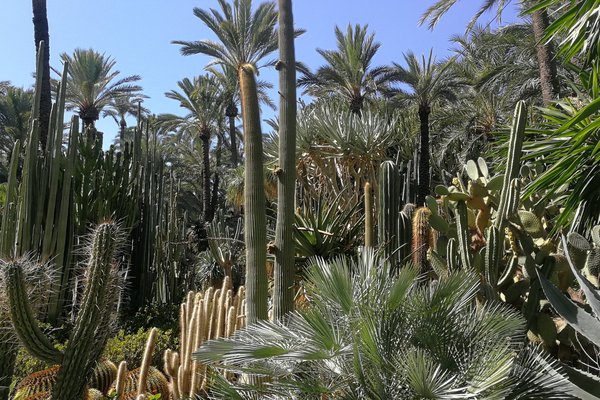Spain
Palmeral of Elche
The Palmeral of Elche is an oasis-like landscape of date palms, transferred to Europe from North Africa by the Moors.
The artificial oasis was constructed during the Arab occupation of this area in Spain over 1,000 years ago and used well-known techniques from the Near East and the Sahara region to let the palm groves grow. The ancient irrigation system, which is still functioning, has been preserved as well.
Community Perspective: Elche has a 5km long Ruta del Palmeral which strings together the main places of interest such as the Palm Grove Museum, the Municipal Park and the botanical garden Huerto del Cura. Additionally, Hubert has described several huertos that have been preserved in such a way that you can still recognise their agricultural function.
Site Info
Official Information
- Full Name
- Palmeral of Elche (ID: 930)
- Country
- Spain
- Status
-
Inscribed 2000
Site history
History of Palmeral of Elche
- 2000: Inscribed
- Inscribed
- 1999: Deferred
- Bureau - concern about heterogeneous nature of sites. Needs a smaller contiguous nomination
- Type
- Cultural
- Criteria
- ii
- v
Links
- UNESCO
- whc.unesco.org
- Official
-
- visitelche.com — Visit Elche
All Links
UNESCO.org
- whc.unesco.org — whc.unesco.org/
Official Website
- visitelche.com — Visit Elche
News Article
- June 30, 2019 theolivepress.es — Thousands of date palms burnt in UNESCO World Heritage orchards
- Aug. 31, 2015 euroweeklynews.com — Elche battles evil weevil invasion to save Unesco heritage palm forest
Community Information
- Community Category
- Human activity: Agriculture
Travel Information
Recent Connections
-
Botanical Gardens
Huerto del CuraSee es.wikipedia.org
-
Cultural landscape not recognized
The Palm Grove may also be considered t… -
Valencia Hotspot
Connections of Palmeral of Elche
- Geography
- World Heritage Process
-
-
Cultural landscape not recognized
The Palm Grove may also be considered to conform with the continuing organic cultural landscape (AB ev)
-
- Human Activity
-
-
Palm Groves
Crit ii and iv both refer to Palms -
Irrigation and drainage
-
- Timeline
-
-
Built in the 8th century
It was with the Arab invasion in the 8th century AD that they began to be cultivated (AB ev)
-
- WHS Hotspots
- Science and Technology
-
-
Botanical Gardens
Huerto del CuraSee es.wikipedia.org
-
News
- theolivepress.es 06/30/2019
- Thousands of date palms burnt in U…
- euroweeklynews.com 08/31/2015
- Elche battles evil weevil invasion…
Recent Visitors
Visitors of Palmeral of Elche
- Afshin Iranpour
- Alexander Barabanov
- Alexander Lehmann
- Alikander99
- Allan Berry
- A. Mehmet Haksever
- Ammon Watkins
- Ana Lozano
- Antonio J.
- Argo
- Artur Anuszewski
- AS
- Atila Ege
- BaziFettehenne
- Bill Maurmann
- Bin
- Birgitte Sørensen
- Bodil Ankerly
- Caspar
- cflw
- ChrisN
- Christian Wagner
- Christravelblog
- Claire Bradshaw
- Clyde
- Csaba Nováczky
- CugelVance
- Daniela Hohmann
- Daniel Chazad
- Dan Pettigrew
- David Aaronson
- David Berlanda
- Dimitar Krastev
- Dorejd
- Dwight Zehuan Xiao
- Elia Vettorato
- Els Slots
- Emilia
- Erik Jelinek
- Evgenii
- Fan Yibo
- Farinelli
- Feldhase
- Femke Roos
- Filip Murlak
- Gary Arndt
- GeorgeIng61
- Gernot
- Hadrianus
- Harald T.
- Harry Mitsidis
- Hubert
- Iain Jackson
- Ian Cade
- Ivan Rucek
- James Bowyer
- janem
- Janos
- Jan-Willem
- Jarek Pokrzywnicki
- Jasam
- Javier
- Jeanne OGrady
- Jens
- Jezza
- Joel on the Road
- Jonas Hagung
- Jonas Kremer
- Jon Eshuijs
- Judit Andrea Juhász
- Karito Vies
- Klaus Freisinger
- krtek
- La Concy
- Lara Adler
- Lazerway
- Lisu Marian
- Loic Pedras
- Luboang
- Luis Filipe Gaspar
- Lukasz Palczewski
- Maciej Gil
- Maciej Gowin
- Martinacurra88
- Martina Rúčková
- Marton Kemeny
- Mateusz
- Matthewsharris
- Max
- M. Huineman
- Michael Novins
- Mikko
- Milan Jirasek
- Msarmiento1979
- nan
- napalm
- Niall Sclater
- Nihal Ege
- nikolamus
- Olli-Pekka Turunen
- PabloNorte
- Patrik
- Paul Schofield
- Persian Globetrotter
- Peter Lööv
- Petteri
- Philipp Leu
- Philipp Peterer
- Piotr Wasil
- Porcho
- preunesco
- Ralf Regele
- Randi Thomsen
- Reza
- rogerding
- Roger Ourset
- Roman Bruehwiler
- Sabrina Liebehentschel
- Sandmann15
- Schnitzel
- scubarrie
- Shandos Cleaver
- Slavi
- Solivagant
- Stanislaw Warwas
- StaziG
- Stefan Loov
- Stijn
- Svein Elias
- Szabolcs Mosonyi
- Szucs Tamas
- Tamara Ratz
- Taotao Chen
- Tarquinio_Superbo
- Thomas Buechler
- Thomas Harold Watson
- Thomas van der Walt
- Tim Allen
- Tom Flaten
- triath
- Vanessa Buechler
- voyager
- Walter
- WILLIAM RICH
- Wojciech Fedoruk
- Xiong Wei
- Xiquinho Silva
- Yongcheng Liu
- Zoë Sheng
Community Reviews
Show full reviews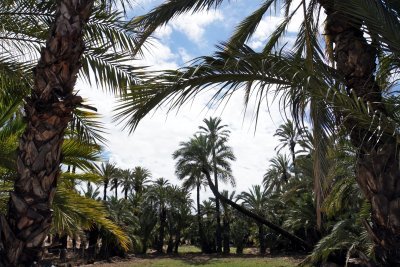
The visit to this WHS left me with mixed impressions and I was unsure how to rate this WHS. The Palmeral has an impressive size, with the core zone covering 144 hectares. It is unique in Europe and "a remarkable example of the transference of a characteristic landscape from one culture and continent to another" (quoted from the justification criterion ii). However, the original layout as an agricultural landscape is no longer visible in large parts of the inscribed area.
The palm groves (huertos) were planted in the 10th century when the region, named Al-Andalus, was under Muslim rule. The Palmeral saw its greatest extension at the end of the 18th and beginning of the 19th century. Since then, the economic importance of date cultivation has declined, industrialisation and increasing urban sprawl have severely affected the agricultural landscape. New roads and railway lines have dissected the formerly contiguous area. Hotels, residential buildings, schools and other public facilities have been built in some of the abandoned huertos. Even a railway station with its large car park is part of the core zone. As a result, the original alignment of the palm trees in a grid-pattern along the irrigation canals has often been destroyed. The intention was to preserve the palm trees, not the agrosystem of the huertos. This can best be seen in the Municipal Park. A beautiful park with all the usual facilities and of course full of palm trees, but that is the only …
Keep reading 0 comments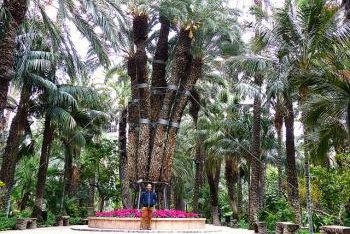
I visited this WHS in March 2016. I spent 2 nights in Elche and a full day exploring the different parts of the Palmeral. The whole Ruta del Palmeral is around 5km but it is quite worthwhile as there are a number of cafes or benches to stop to relax or grab a coffee. It starts and ends at the Huerto de San Plácido which has a Unesco sign and a map of the trail next to the entrance. In all there are 20 groves with a total of 200,000 trees and 70,000 date palm trees. Some are relatively new and are not part of the inscription. The best viewpoint is opposite the bridge next to the Palacio De Altamira moorish fortress and the blue-domed Basilica de Santa Maria. Although when walking the trail, the Palmeral seems like a huge park or garden, it was originally a plantation with an agriculture purpose, and thus its plots (huerta) are referred to as groves. Each of the groves is flanked by rows of date palm trees, in such a way that, when viewed from the air, they form a grid pattern. The origins of the palm grove date back to the tenth century, when the Arabs relocated the city to its current site. During the Ruta del Palmeral you'll visit the Palm Grove Museum which will help to give you a context to better appreciate the site. Moreover, you will see several palm trees with different shapes and forms, mainly at the …
Keep reading 0 comments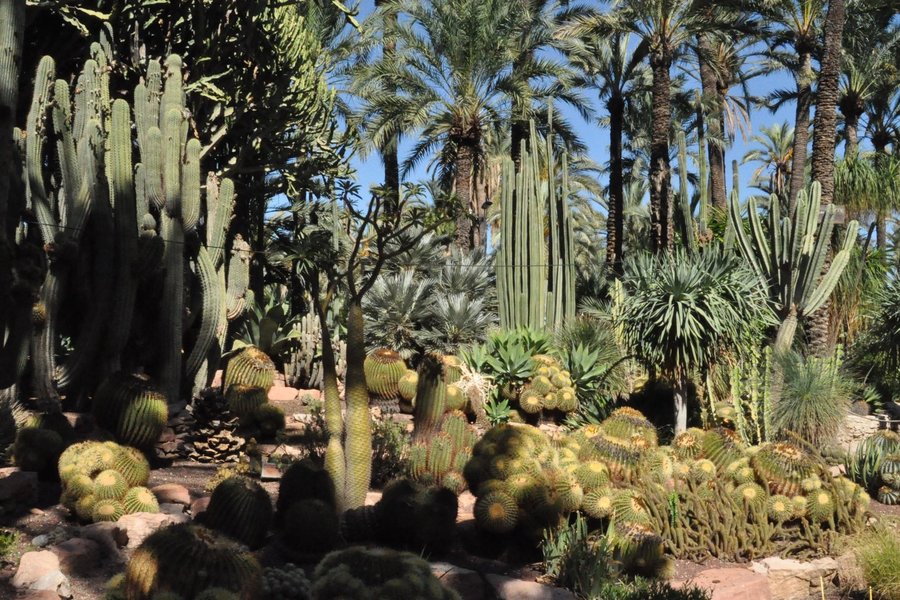
This is a really interesting and unique site to visit - a true oasis in a very desert-like landscape in southeastern Spain. The moment you step out of Elche's train station, you are surrounded by palms of all kinds, shapes and sizes. The Municipal Park between the station and the tourist office features a large variety, but the most important and famous sight of Elche is the Huerto del Cura, a very nice botanic garden with ponds, statues, etc. The nearby San Placido garden includes a small, but interesting museum about the history and biology of the palm trees. Elche is quite a pleasant city with several interesting sights in the Old Town. If you have been to Granada and the Alhambra already, you have seen the major testament to the Arabs' centuries-long occupation of the Iberian peninsula. The Palmeral is probably the second-most important Arab monument in Europe, and definitely worth a visit.
Keep reading 0 comments
After exiting the Elx Parc station and visiting the Tourist Office, I followed the walking tour described in their pamphlet, around the Parc del Filet de Fora. Here I found trees and aflaj (irrigation channels) similar to those in Oman and Al Ain (UAE). About two thirds of the way around the tour I stopped for an excellent salad lunch at the Santa Fe cafe.
Keep reading 0 comments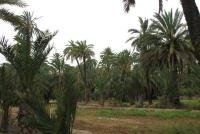
In our trip to Spain we have been to the Palmeral of Elche, the most important complex of date palm groves in Europe, laid out by the Arab Muslims at the end of the 10th century as an oasis, a system of agricultural production in arid areas. The city of Elche and its centre are completely surrounded on the east by an incredibly large and continuous area of palm trees (some higher than 30 metres and older than 300 years), interrupted only by main traffic roads. The palms are everywhere, touching the houses of the outskirts and also inserting in the middle of them.
First we stopped at the Tourist Office where they have many information about the Palmeral, near which there are beautiful views of this “sea of palms” from the bridges over the river Vinalopó.
In the middle of the Palmeral there are four places, of which we have seen two, regarded as the most interesting features, mainly parks. First we went to the Municipal Park: here you can have a pleasant walk on gravelly paths in the middle of palms. The small park is laid out exactly like an urban garden with all its facilities, with palms combined with a lot of other species of plants, often flowering, situated in modern flower-beds.
Then we have been to the Huerto del Cura, a park similar to the Municipal one, but finer and comparable to a small botanical garden (the ticket for which is highly overpriced – 5 Euro), …
Keep reading 0 comments
